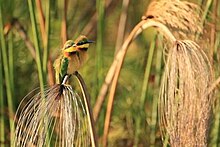Miniature pinto
| Miniature pinto | ||||||||||||
|---|---|---|---|---|---|---|---|---|---|---|---|---|

Pygmy pint ( Merops pusillus ) |
||||||||||||
| Systematics | ||||||||||||
|
||||||||||||
| Scientific name | ||||||||||||
| Merops pusillus | ||||||||||||
| Statius Müller , 1776 |
The miniature pint ( Merops pusillus ) is a bird of the genus Merops and the bee-eater family (Meropidae). It occurs in a large part of Africa south of the Sahara . Train movements are limited to short distances depending on the rainfall.
Appearance
Like other bee-eaters, the miniature pint is a slim, colorful bird. Its upper side is green, the throat yellow, a black collar is followed by a chestnut brown chest that fades to beige towards the belly. The wings are green-brown and the beak black. The dwarf pint grows to a length of 15 to 17 centimeters, making it the smallest bee-eater species .
As a frequent and trusting bird , the miniature pint is well known in its area of distribution. It is estimated that there are 60–80 million miniature spiders.
distribution and habitat
The miniature spint breeds in open bushland, preferably near water. As a typical bee-eater, it mainly feeds on insects, especially bees , wasps and hornets , which it catches in flight from a raised hide. These waiting areas are often less than a meter high. Before eating, it hits the prey several times on a hard surface so that it can no longer sting.
Way of life
In contrast to other bee-eaters, the miniature pint does not breed in colonies. He digs a brood tube in sandy banks or in the entrance area of an aardvark den ; Males and females take turns breeding. Miniature spiders form sleeping communities on trees. Your reputation is a soft "siip".
The miniature pint is not a migratory bird, but a stationary bird. The birds leave their home area when it gets too dry there. Mostly they fly to the wetter east, but return later.
The breeding season begins in September, at the beginning of southern summer, and lasts until February. During this time, heavy rainfall is not to be expected, which would otherwise endanger the nests - on rivers or directly on sandbanks - and the brood.
Subspecies
There are five known subspecies :
- M. p. meridionalis - Distribution: Uganda (with the exception of the northwest) and West Kenya , south to Angola and KwaZulu-Natal ; Appearance: green forehead; short, narrow, light blue stripe above the eye; very thin, blue-white line between throat and collar
- M. p. argutus - distribution: at the southern limit of distribution of M. p. meridionalis , from southwest Angola to southwest Zimbabwe and Botswana ; appearance: paler than M. p. meridionalis - with a slightly smaller collar
- M. p. cyanostictus - distribution: overlaps with M. p. meridionalis in the Kenyan highlands and from there through the dry east and north of Kenya to northern Somalia and eastern Ethiopia ; Appearance: forehead and wide light blue stripe above the eye; tight purple-blue line between throat and collar
- M. p. ocularis - Distribution: Upper Uelle in the Democratic Republic of the Congo and northwest Uganda to Equatoria in Sudan , northwest Ethiopia and Eritrea . Overlaps with M. p. cyanostictus in a 200 km wide corridor; Appearance: like M. p. meridionalis , but paler lower body and eyebrows are less emphasized.
- M. p. pusillus - Distribution: reaches from Senegal to 29 ° East in Sudan, north in the Mali to 17 ° North and south in the Democratic Republic of the Congo to 4 ° North. Appearance: forehead and eyebrows green; no blue line between throat and collar, sometimes a very light, narrow, deep blue line
literature
- C. Hilary Fry , Kathie Fry, Alan Harris: Kingfishers, Bee-eaters and Rollers. ISBN 0-7136-8028-8 (English).
- JA Harrison, DG Allan, LG Underhill, M. Herremans, AJ Tree, V. Parker, CJ Brown: Atlas of the Southern African Birds. Volume 1: Non-Passerines. BirdLife South Africa, Johannesburg 1997, ISBN 0-620-20730-2 , p. 674 (English).
Web links
- Merops pusillus in the endangered Red List species the IUCN 2008. Posted by: BirdLife International, 2008. Accessed on December 19 of 2008.
- Videos, photos and sound recordings of Merops pusillus in the Internet Bird Collection
Individual evidence
- ↑ Elke Brüser: Tiny among the bee-eaters. In: www.fluegelschlag-birding.de. Elke Brüser, September 17, 2019, accessed on February 19, 2020 (German).
- ↑ Harrison, 1997, p. 674.

